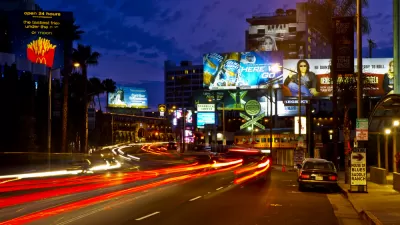The original "Blade Runner" takes place in the Los Angeles of November 2019. How does the film’s vision of the city compare with the present-day reality?

The 1982 film "Blade Runner" envisioned a Los Angeles of the future—this month, November 2019. The LAist staff takes a closer look at what Ridley Scott’s world looked like compared to real-life Los Angeles.
The movie version of the city depicts a dreary and smog-choked environment that no one talks about. "By contrast, the actual November 2019 is inundated with research, fear, conversation and controversy over the 'untold suffering' that climate change will bring."
And the demographics of the Blade Runner Los Angeles look a bit peculiar. It is, inexplicably, a city populated by Asian people wearing bamboo hats and carrying oil paper umbrellas, with few other people of color. "While Blade Runner doesn't nail the population breakdown, its instincts are right when it comes to its portrayal of a multicultural — and inequitable — future for L.A."
The article also looks at the flying cars, replicants, hyper-dense urban landscape, and housing of the sci-fi version of Los Angeles. While many of these features do not quite match up with Los Angeles as we know it, the influences behind these visions of the future and the ways they diverge from real life are interesting to consider.
FULL STORY: How The Dark Future Of Blade Runner's 2019 Los Angeles Looks In The Light Of Actual Today

Planetizen Federal Action Tracker
A weekly monitor of how Trump’s orders and actions are impacting planners and planning in America.

Maui's Vacation Rental Debate Turns Ugly
Verbal attacks, misinformation campaigns and fistfights plague a high-stakes debate to convert thousands of vacation rentals into long-term housing.

Restaurant Patios Were a Pandemic Win — Why Were They so Hard to Keep?
Social distancing requirements and changes in travel patterns prompted cities to pilot new uses for street and sidewalk space. Then it got complicated.

In California Battle of Housing vs. Environment, Housing Just Won
A new state law significantly limits the power of CEQA, an environmental review law that served as a powerful tool for blocking new development.

Boulder Eliminates Parking Minimums Citywide
Officials estimate the cost of building a single underground parking space at up to $100,000.

Orange County, Florida Adopts Largest US “Sprawl Repair” Code
The ‘Orange Code’ seeks to rectify decades of sprawl-inducing, car-oriented development.
Urban Design for Planners 1: Software Tools
This six-course series explores essential urban design concepts using open source software and equips planners with the tools they need to participate fully in the urban design process.
Planning for Universal Design
Learn the tools for implementing Universal Design in planning regulations.
Heyer Gruel & Associates PA
JM Goldson LLC
Custer County Colorado
City of Camden Redevelopment Agency
City of Astoria
Transportation Research & Education Center (TREC) at Portland State University
Jefferson Parish Government
Camden Redevelopment Agency
City of Claremont





























